Sponsored by HORIBAOct 18 2013
Many industrial applications are available for water- and solvent-based coatings, such as paper coatings, foils for LCD panels, adhesives and varnishes, etc. Coatings for these products are usually made from dissolved coating components that are applied to the substrate and then dried to produce the preferred material. The quality and performance of the end product is often determined by the coating’s drying process. In order to design and control such coating and drying procedures, online measurements of solvent and moisture profiles during the coating formation is required.
Inverse-Micro-Raman-Spectroscopy (IMRS)
A measuring technique dubbed Inverse-Micro-Raman-Spectroscopy (IMRS) was applied to a Confocal Raman Spectrometer (HORIBA LabRAM INV), whereby the traditional upright LabRAM microscope was substituted by an Inverted Microscope sampling system - Olympus IX50.
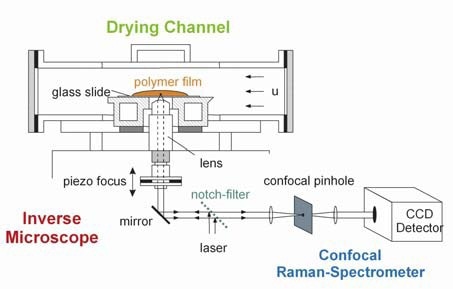
Figure 1. Inverse-Micro-Raman-Spectroscopy (IMRS) technique
The initial work obtained through this combination demonstrated the benefits of using Raman spectroscopy for studying the drying characteristics in coating materials. The work has shown that the IMRS method allows the measurement of solvent content in in-situ, within thin films online and with a high spatial resolution of up to 1^m. Through this method, kinetic and temporal resolution of up to 0.5s was also achieved. Quantitative measurements can be obtained by using certain calibration procedures.
Instrumentation
For the study, the LabRAM INV Raman microscope was used that employs the typical backscattering Raman geometry wherein the laser beam is transmitted via the optical microscope and irradiates the sample. With the same objective, the backscattered light is collected and transferred to the integrated spectrometer. Since the LabRAM INV provides the inverted geometry, the sample is lighted up from below with the focused laser spot located within the sample volume by way of a piezo Z-axis nano-positioning system.
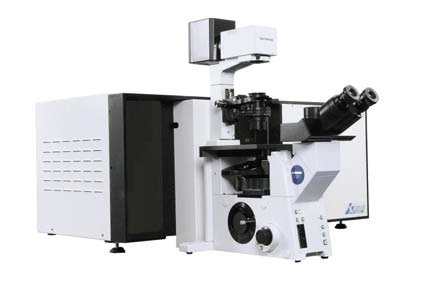
Figure 2. The HORIBA LabRAM INV
The rest of the system’s design remains the same as that of the more traditional Raman microscope with the scattered light focused via a holographic notch-filter to eliminate the Rayleigh scattered light.
The confocal pinhole integrated into the system controls the spatial filtering and makes sure that only light from a controlled sampled volume is detected. Using such a spatial and depth control mechanism is essential because without it, a device’s spectral components and artefacts from scattered light produced from the desired position within the sample, would also be detected and consequently affect the quality of data.
Solvent-based Coatings
To prepare a sample, a liquid polymer solution is spread on a thermostated copper plate with a glass slide placed in the middle of the plate. Figure 3 shows the Raman spectra in different layers of a solvent borne polymer coating during drying.
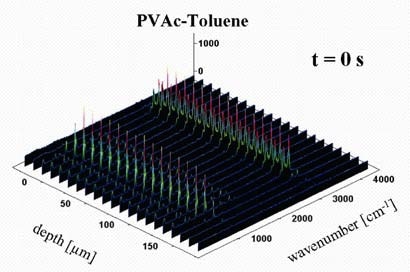
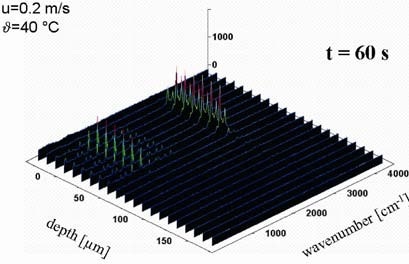
Figure 3. Raman spectra at different depths of a polymeric solvent coating during the drying process, measured with the IMRS-technique.
Calibration measurements are required to achieve quantitative solvent content data. A calibration can be carried out by obtaining Raman spectra of a calibration set of samples made with different concentrations in sealed optical cells. Figure 4 shows the calculated solvent concentration profiles from measured data.
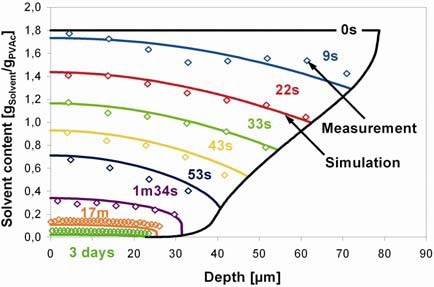
Figure 4. Measured concentration profiles in a polymer solution (polyvinylacetatetoluene) during the drying process.
Moreover, the reduction of the coating surface is also plotted. At the end of the drying process, steeper concentration profiles can be determined as a dry skin forms at the surface. The entire drying process is controlled by the diffusion of the solvent through this skin and even after three days of drying a considerable amount of solvent can still be measured. In the coating industry, this phenomenon is called as "skinning".
Water-based Coatings
Developing new waterborne latex systems to substitute the standard solvent-based polymeric coatings is very challenging. Adhesives, paints, etc would benefit from the use of systems that have minimum environmental impact, but which complement the drying behaviour and properties of solvent-based polymeric films. Compared to solvent-based paints, water-based decorative topcoats still show low-grade application properties and the quality of the final polymer film is usually characterized by poor resistance to dissolution by water and an inferior finish.
A number of physicochemical parameters such as physical characteristics and glass transition temperature of polymers, and the composition of the latex dispersion are likely to control the application properties and final film quality in such a coating. Till date, the particular effects of these parameters in water-based systems remain largely unknown.
Conclusion
In this study, the IMRS technique was used to obtain the first experimental data on factors that influence the application and final film properties. To sum up, combining the power of confocal Raman microscopy to the inverted sampling geometry has allowed comprehensive analysis of water- and solvent-based coating systems, and provided vital information about the chemistry and processes that occur at the coating interface.

This information has been sourced, reviewed and adapted from materials provided by HORIBA.
For more information on this source, please visit HORIBA.